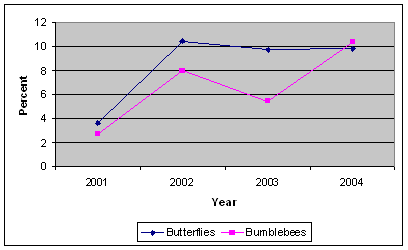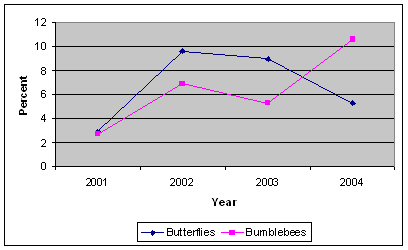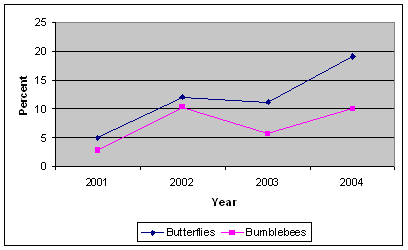|
Year |
(Windmill Hill) |
Blackminster |
Blackminster | ||
|
(Butterflies) |
Butterflies |
Bumblebees | |||
|
NUMBER (26 WEEK TOTAL) |
|||||
|
2001 |
1872 |
68 |
51 |
||
|
2002 |
1666 |
175 |
134 |
||
|
2003 |
2076 |
203 |
114 |
||
|
2004 |
1473 |
145 |
154 |
||
|
NUMBER PER KILOMETER (26 WEEK TOTAL) |
|||||
|
2001 |
1232 |
44.4 |
33.3 |
||
|
2002 |
1096 |
114.4 |
87.6 |
||
|
2003 |
1366 |
132.7 |
74.5 |
||
|
2004 |
969 |
94.8 |
100.7 |
||
|
AS PERCENT OF WINDMILL HILL BUTTERFLIES |
|||||
|
2001 |
100 |
3.61 |
2.71 |
||
|
2002 |
100 |
10.44 |
7.99 |
||
|
2003 |
100 |
9.71 |
5.46 |
||
|
2004 |
100 |
9.78 |
10.39 |
||
|
Table 2 Results From All Sections |
|||||

Figure
1
Results From All Sections
(As percent of Windmill Hill butterflies)
|
Year |
Blackminster |
Blackminster |
|
Butterflies |
Bumblebees |
|
|
NUMBER (26 WEEK TOTAL) |
||
|
2001 |
37 |
34 |
|
2002 |
109 |
78 |
|
2003 |
127 |
75 |
|
2004 |
53 |
106 |
|
NUMBER PER KILOMETER (26 WEEK TOTAL) |
||
|
2001 |
35.8 |
32.9 |
|
2002 |
105.5 |
75.5 |
|
2003 |
122.9 |
72.6 |
|
2004 |
51.3 |
102.6 |
|
AS PERCENT OF WINDMILL HILL BUTTERFLIES |
||
|
2001 |
2.91 |
2.67 |
|
2002 |
9.63 |
6.89 |
|
2003 |
9 |
5.32 |
|
2004 |
5.29 |
10.59 |
|
Table 3 Results Away From Orchard (Length 1.033 km) | ||

Figure 2
Results Away From Orchard)
(As percent of Windmill Hill butterflies)
|
Year |
Blackminster |
Blackminster |
|
Butterflies |
Bumblebees |
|
|
NUMBER (26 WEEK TOTAL) |
||
|
2001 |
31 |
17 |
|
2002 |
66 |
56 |
|
2003 |
76 |
39 |
|
2004 |
92 |
48 |
|
NUMBER PER KILOMETER (26 WEEK TOTAL) |
||
|
2001 |
62.2 |
34.1 |
|
2002 |
132.5 |
112.4 |
|
2003 |
152.6 |
78.3 |
|
2004 |
184.7 |
96.4 |
|
AS PERCENT OF WINDMILL HILL BUTTERFLIES |
||
|
2001 |
5.05 |
2.77 |
|
2002 |
12.09 |
10.26 |
|
2003 |
11.17 |
5.73 |
|
2004 |
19.06 |
9.95 |
|
Table4. Results From Around Orchard (Length 0.498 kilometers) |
||

Figure 3
Results From Around Orchard)
(As percent of Windmill Hill butterflies)
|
Species |
No. |
|
Small/Essex Skipper |
20 |
|
Large Skipper |
1 |
|
Brimstone |
3 |
|
Large White |
14 |
|
Small White |
187 |
|
Green-veined White |
65 |
|
Orange Tip |
4 |
|
Small Copper |
1 |
|
Common Blue |
4 |
|
Red Admiral |
1 |
|
Painted Lady |
3 |
|
Small Tortoiseshell |
41 |
|
Peacock |
4 |
|
Comma |
1 |
|
Marbled White |
2 |
|
Gatekeeper |
83 |
|
Meadow Brown |
152 |
|
Ringlet |
5 |
|
Sum |
591 |
|
Table 5. Total numbers recorded over 4 years |
|